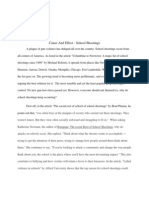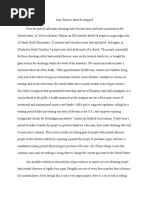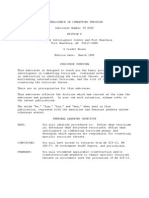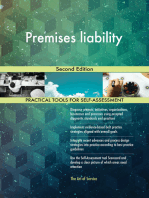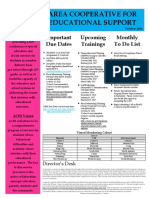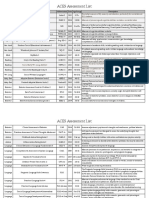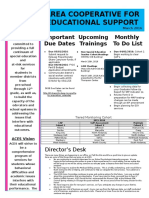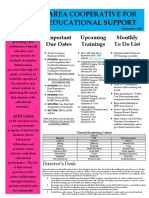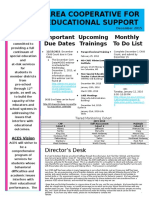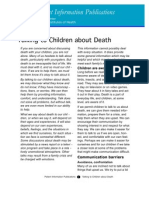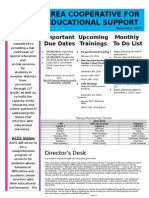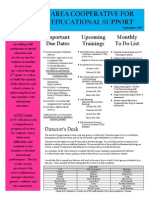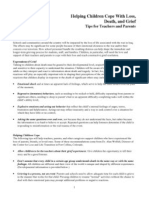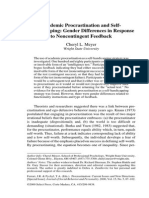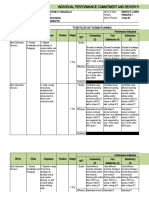8-07 Threat Determination Document
8-07 Threat Determination Document
Uploaded by
api-83101465Copyright:
Available Formats
8-07 Threat Determination Document
8-07 Threat Determination Document
Uploaded by
api-83101465Original Title
Copyright
Available Formats
Share this document
Did you find this document useful?
Is this content inappropriate?
Copyright:
Available Formats
8-07 Threat Determination Document
8-07 Threat Determination Document
Uploaded by
api-83101465Copyright:
Available Formats
THREAT DETERMINATION What is a threat assessment?
Threat assessment is the process of evaluating the risk of violence posed by someone who has expressed the intent to inflict harm on another. Threat assessment evaluates the context and circumstances of the threat in order to uncover any evidence that the threat may be carried out. A priority of threat assessments is the development of interventions and follow-up activities that are designed to manage and reduce the risk of violence. Who conducts a threat assessment? Threat assessments are conducted by a multidisciplinary team including: 1. School administrators 2. Mental health professionals (school psychologist, counselor, social worker) 3. School police officer 4. Other professionals (school nurse, teacher) Components of threat assessments: Identification- Identify threats made by students. Evaluation- Evaluate the seriousness of the threat and the danger it poses to others. Discriminate between threats in acknowledgement that not all are the same. *Making a threat is not the same as posing a threat. Is the student on a path toward an attack? (Secret Service/DOE guide). 3. Intervention- Reduction of violence risk. 4. Follow-up- Assessment of intervention strategies and outcomes.
1. 2.
What is a threat? A threat is an expression of intent to harm someone. Threats can be verbal, gestured, or written. They may also be direct or indirect. Weapon possession is presumed to be a threat unless circumstances clearly indicate otherwise:
Direct- Im going to stab you with a hunting knife after school. Indirect- I have the means to do some major destruction here. Third Party- He is going to get what is coming to him. Wait and see. Conditional- You better change my grade or I will kill you. Veiled- My brothers in Red Lake knew how to set things right.
Determination of the seriousness of the threat: Transient Threat or Serious Substantive Threat Not Requiring a Comprehensive Threat Assessment:
Most threats do not genuinely express intent to harm. They may be an expression of feelings of anger or frustration that are temporary in nature. Usually they can be resolved at the office or on the scene.
After some resolution, the threat does not exist anymore. They usually end with an apology or clarification.
Actions following a transient/serious substantive threat: Safety precautions may not be necessary. See that the threat is resolved through conflict resolution, apologies, explanations, making amends. Provide counseling and education where appropriate. Take disciplinary actions if necessary.
Factors to consider: Credibility of student and willingness to acknowledge his/her behavior. Credibility of witness accounts. Age of student, developmental factors. Capability of student to carry out the threat. Students discipline history. When in doubt, treat threats as a very serious substantive threat requiring a comprehensive threat assessment. Substantive threats of assault are serious substantive threats and Threat Assessment Team decides whether a comprehensive threat assessment is warranted or not (Im gonna beat him up).
Very serious or substantive threat requiring comprehensive threat assessment: A very serious substantive threat is much more serious and includes the following components: Intent to injure is beyond immediate situation. There is at least some risk that threat will be carried out. Requires protective action. Police intervention or consultation may be required to address legal violations. The safety of the campus must be maintained if the student is suspended.
Indicators of very serious substantive threats/threats requiring comprehensive threat assessment: Specific, plausible details (Im going to blast Sam Taylor with my pistol.). Threat has been repeated over time (Hes been telling everyone hes going to get you.). Threat reported as a plan or evidence of planning (Wait til you see what happens next Tuesday in the library.). Accomplices or recruitment of accomplices. Physical evidence of intent (written plan, lists of victims, bomb materials, etc.).
Actions following a very serious substantive threat/substantive threat requiring comprehensive evaluation: If danger is imminent, notify law enforcement immediately.
Take precautions to protect potential victims. Notify intended victim and victims parents. Notify parents of student who has made threat. Conduct threat assessment, and assess for historical, social/contextual, individual, and protective factors. Discipline student as appropriate. Ensure safety of student and campus if student is suspended.
Action Plan and interventions (Goal is to reduce the risk of violence): Develop a plan for teaching and for supporting new behavior (e.g., counseling, conflict resolution, etc.). Plan for implementation and monitoring. Set up a timeline to review plan. Document and describe success.
You might also like
- Mathematics For All The Role of Numeracy in National Math Program100% (13)Mathematics For All The Role of Numeracy in National Math Program94 pages
- Assembly of Lansing Pastors Mayoral RequestNo ratings yetAssembly of Lansing Pastors Mayoral Request22 pages
- #17-013 Rush - Arbitration Opinion & Award - Redacted Decision100% (2)#17-013 Rush - Arbitration Opinion & Award - Redacted Decision80 pages
- The Importance of Ethics in Criminal Justice100% (1)The Importance of Ethics in Criminal Justice2 pages
- PPD Independent Investigation Final Report and CM Cover MemoNo ratings yetPPD Independent Investigation Final Report and CM Cover Memo64 pages
- Foreign Languages (9-1) : Support For Cambridge IGCSE100% (1)Foreign Languages (9-1) : Support For Cambridge IGCSE2 pages
- Should The President Have Unilateral War Powers0% (1)Should The President Have Unilateral War Powers5 pages
- Police Uniform and Its Impact On Public Perceptions 3100% (1)Police Uniform and Its Impact On Public Perceptions 316 pages
- Human Behavior and Victimology PrefinalsNo ratings yetHuman Behavior and Victimology Prefinals38 pages
- Download Complete A Street Survival Guide for Public Safety Officers The Cop Doc s Strategies for Surviving Trauma Loss and Terrorism 1st Edition Daniel Rudofossi PDF for All Chapters100% (5)Download Complete A Street Survival Guide for Public Safety Officers The Cop Doc s Strategies for Surviving Trauma Loss and Terrorism 1st Edition Daniel Rudofossi PDF for All Chapters81 pages
- The Vital Role of Police in Gun ViolenceNo ratings yetThe Vital Role of Police in Gun Violence3 pages
- Terrorism in Indonesia An Examination of Ten Radical Groups (PDFDrive)100% (1)Terrorism in Indonesia An Examination of Ten Radical Groups (PDFDrive)231 pages
- Crime Mapping News Vol 2 Issue 3 (Summer 2000)100% (1)Crime Mapping News Vol 2 Issue 3 (Summer 2000)12 pages
- Countering Violent Extremism: Community Perspectives and ConcernsNo ratings yetCountering Violent Extremism: Community Perspectives and Concerns8 pages
- Proposal For Prevention of School Shootings Wri 013013No ratings yetProposal For Prevention of School Shootings Wri 0130136 pages
- ,,terrorism - An Actual Problem": (Summary)No ratings yet,,terrorism - An Actual Problem": (Summary)3 pages
- "The FBI Is Reading Over Your Shoulder." - Surveillance Technique100% (2)"The FBI Is Reading Over Your Shoulder." - Surveillance Technique5 pages
- Best Practices For Embedding A Social Worker Within Your Police DepartmentNo ratings yetBest Practices For Embedding A Social Worker Within Your Police Department4 pages
- Health and Safety: 15.00 Chapter OutlineNo ratings yetHealth and Safety: 15.00 Chapter Outline66 pages
- Predictive Validity of The Structured Assessment of Violence Risk in YouthNo ratings yetPredictive Validity of The Structured Assessment of Violence Risk in Youth16 pages
- Stearns County Attorney's Letter On Justified Use of Deadly Force by Off-Duty OfficerNo ratings yetStearns County Attorney's Letter On Justified Use of Deadly Force by Off-Duty Officer3 pages
- 2022.04.13 South Carolina Agreement Final Signed 0No ratings yet2022.04.13 South Carolina Agreement Final Signed 020 pages
- Psychiatries Hand in School Shootings and Violence100% (4)Psychiatries Hand in School Shootings and Violence31 pages
- Law Enforcement Officers Fatalities ReportNo ratings yetLaw Enforcement Officers Fatalities Report14 pages
- Violence Risk - Assessment and Management: Advances Through Structured Professional Judgement and Sequential RedirectionsFrom EverandViolence Risk - Assessment and Management: Advances Through Structured Professional Judgement and Sequential RedirectionsNo ratings yet
- Bipolar Disorder: Educational Implications For Secondary StudentsNo ratings yetBipolar Disorder: Educational Implications For Secondary Students4 pages
- Death and Grief:: Supporting Children and YouthNo ratings yetDeath and Grief:: Supporting Children and Youth3 pages
- A Contemporary Model of Residential Care For Children and Young People in Care 2010No ratings yetA Contemporary Model of Residential Care For Children and Young People in Care 201096 pages
- Academic Procrastination and Self-Handicapping100% (1)Academic Procrastination and Self-Handicapping17 pages
- English Sample Unit: Let's Talk! Stage 1No ratings yetEnglish Sample Unit: Let's Talk! Stage 16 pages
- Nonstop LET Review 2020 - Daily Question and Answer Recap - LPT Ft. RCHNo ratings yetNonstop LET Review 2020 - Daily Question and Answer Recap - LPT Ft. RCH45 pages
- Individual Performance Commitment and Review Form (Ipcrf) For Teacher I-IiiNo ratings yetIndividual Performance Commitment and Review Form (Ipcrf) For Teacher I-Iii22 pages
- Required Reading No. 4 - Assessment of Learning 1No ratings yetRequired Reading No. 4 - Assessment of Learning 115 pages
- HPXN200-1-Course Outline-Jan-Jun2023-CZ-V.2-31012023No ratings yetHPXN200-1-Course Outline-Jan-Jun2023-CZ-V.2-3101202380 pages
- Tvet Curriculum Course Unit - For MergeNo ratings yetTvet Curriculum Course Unit - For Merge43 pages











